RPA in Auditing and Accounting Sector: A Detailed Analysis Report
VerifiedAdded on 2023/01/13
|11
|2441
|29
Report
AI Summary
This report examines the application of Robotic Process Automation (RPA) in the accounting sector, focusing on its potential to improve auditing processes. It defines RPA, highlighting its role in automating repetitive tasks and enhancing efficiency. The report discusses the benefits of RPA, including improved accuracy, increased productivity, and cost savings. It explores opportunities for internal audits within intelligent automation, such as in public accounting practices and dual-purpose audit tests. The report also outlines a three-step implementation process for RPA-based audits, covering process understanding, audit data standardization, and automated audit test execution. The conclusion emphasizes RPA's transformative potential for the accounting sector, with recommendations for its adoption to streamline processes and enhance customer experiences. Programming languages like Python and R are also discussed as they are used to improve RPA technology and increase processing efficiency.
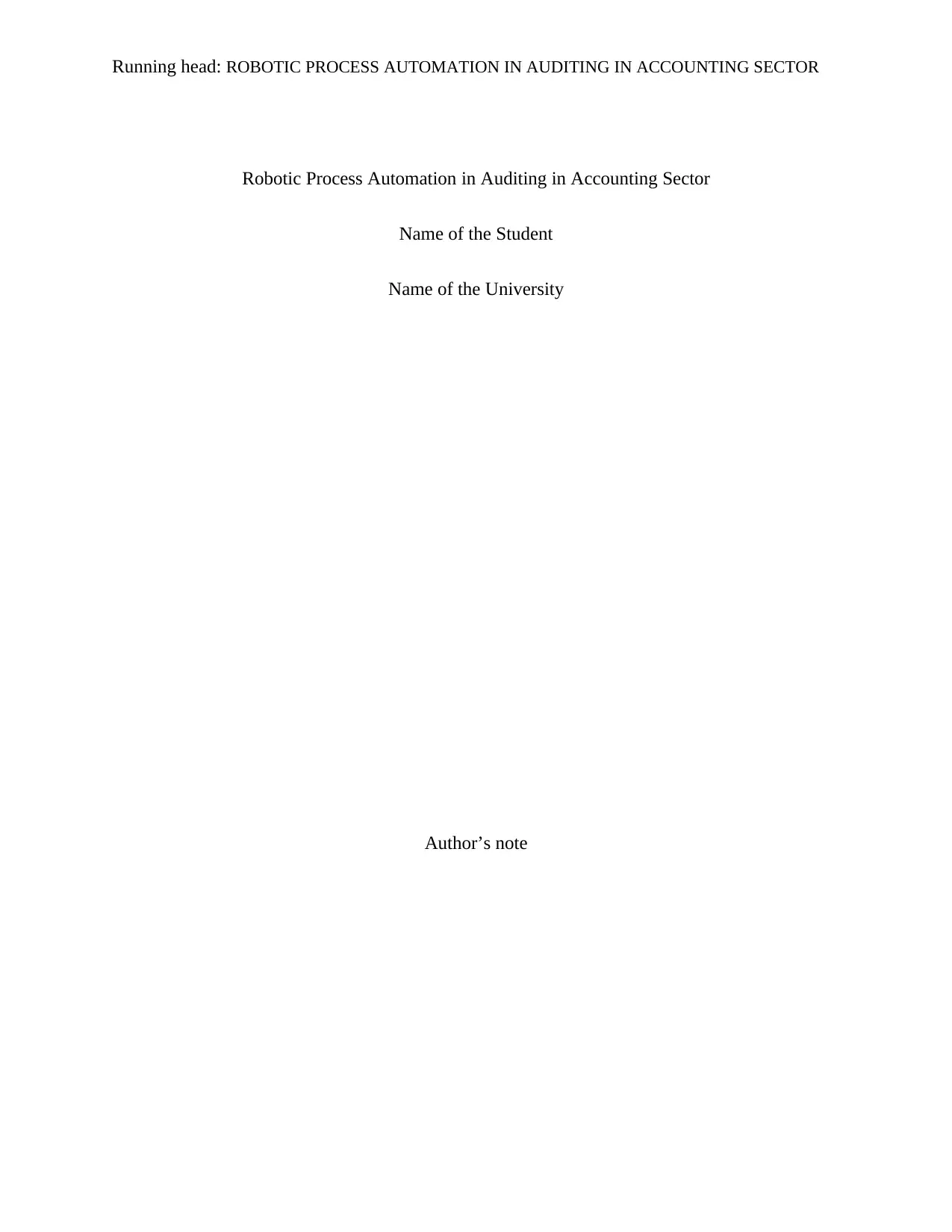
Running head: ROBOTIC PROCESS AUTOMATION IN AUDITING IN ACCOUNTING SECTOR
Robotic Process Automation in Auditing in Accounting Sector
Name of the Student
Name of the University
Author’s note
Robotic Process Automation in Auditing in Accounting Sector
Name of the Student
Name of the University
Author’s note
Paraphrase This Document
Need a fresh take? Get an instant paraphrase of this document with our AI Paraphraser
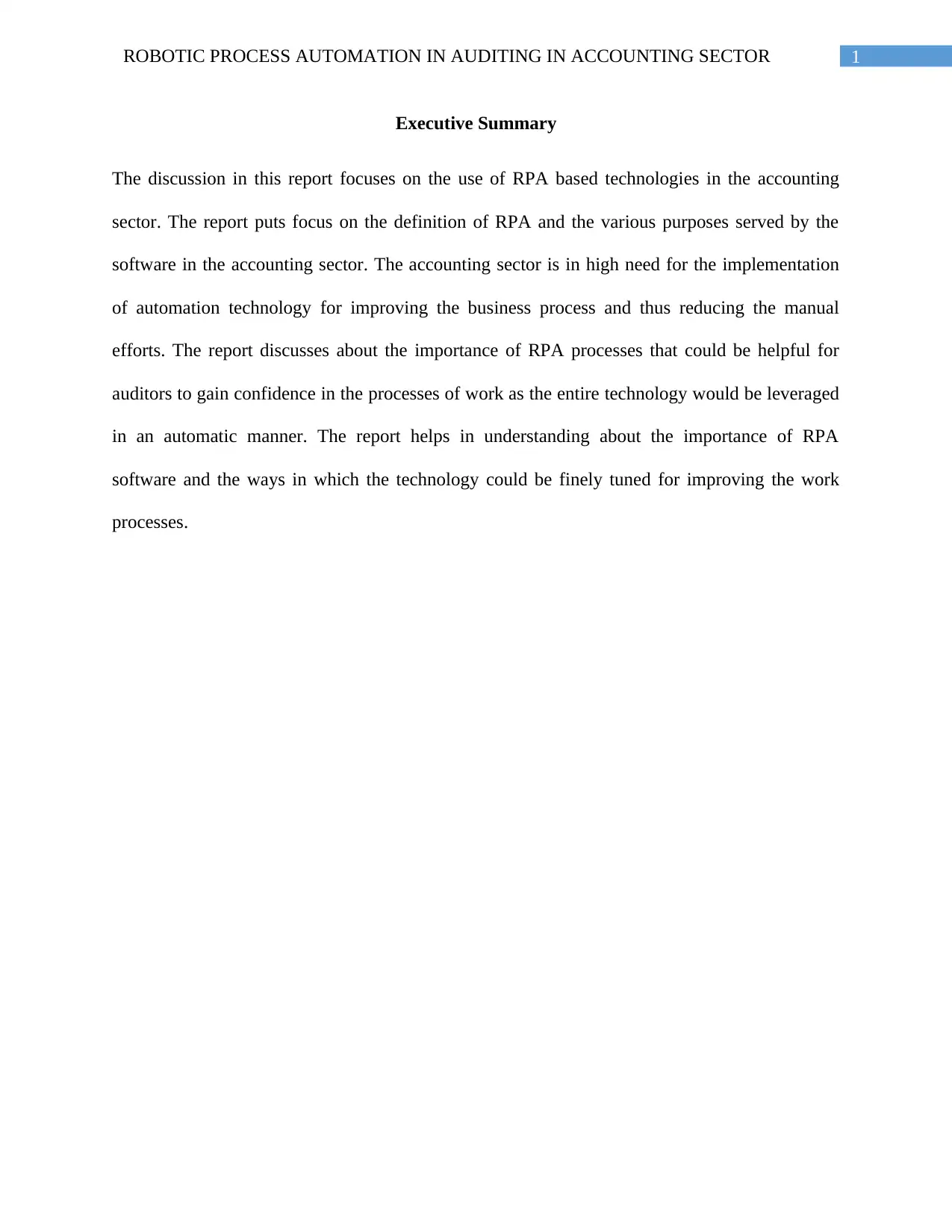
1ROBOTIC PROCESS AUTOMATION IN AUDITING IN ACCOUNTING SECTOR
Executive Summary
The discussion in this report focuses on the use of RPA based technologies in the accounting
sector. The report puts focus on the definition of RPA and the various purposes served by the
software in the accounting sector. The accounting sector is in high need for the implementation
of automation technology for improving the business process and thus reducing the manual
efforts. The report discusses about the importance of RPA processes that could be helpful for
auditors to gain confidence in the processes of work as the entire technology would be leveraged
in an automatic manner. The report helps in understanding about the importance of RPA
software and the ways in which the technology could be finely tuned for improving the work
processes.
Executive Summary
The discussion in this report focuses on the use of RPA based technologies in the accounting
sector. The report puts focus on the definition of RPA and the various purposes served by the
software in the accounting sector. The accounting sector is in high need for the implementation
of automation technology for improving the business process and thus reducing the manual
efforts. The report discusses about the importance of RPA processes that could be helpful for
auditors to gain confidence in the processes of work as the entire technology would be leveraged
in an automatic manner. The report helps in understanding about the importance of RPA
software and the ways in which the technology could be finely tuned for improving the work
processes.
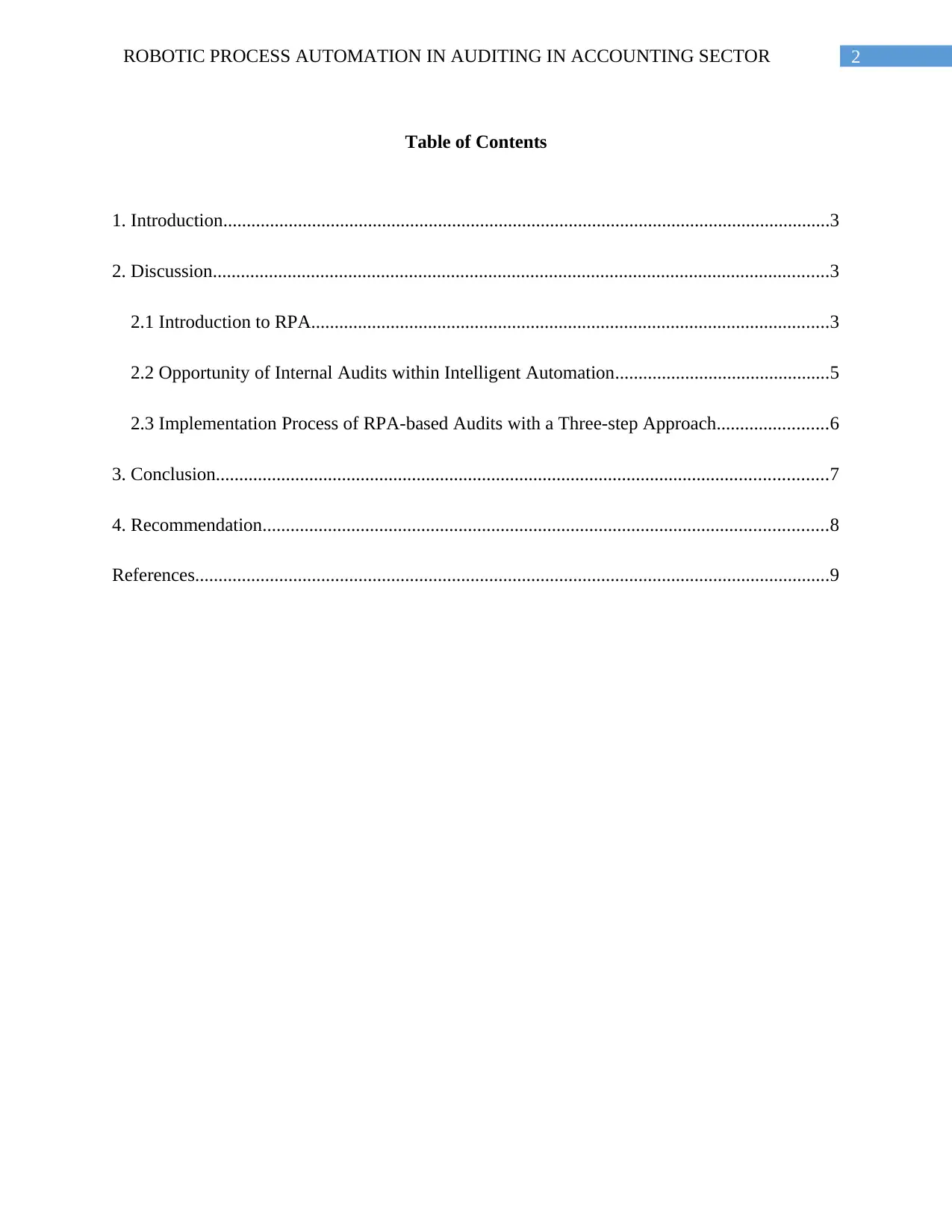
2ROBOTIC PROCESS AUTOMATION IN AUDITING IN ACCOUNTING SECTOR
Table of Contents
1. Introduction..................................................................................................................................3
2. Discussion....................................................................................................................................3
2.1 Introduction to RPA...............................................................................................................3
2.2 Opportunity of Internal Audits within Intelligent Automation..............................................5
2.3 Implementation Process of RPA-based Audits with a Three-step Approach........................6
3. Conclusion...................................................................................................................................7
4. Recommendation.........................................................................................................................8
References........................................................................................................................................9
Table of Contents
1. Introduction..................................................................................................................................3
2. Discussion....................................................................................................................................3
2.1 Introduction to RPA...............................................................................................................3
2.2 Opportunity of Internal Audits within Intelligent Automation..............................................5
2.3 Implementation Process of RPA-based Audits with a Three-step Approach........................6
3. Conclusion...................................................................................................................................7
4. Recommendation.........................................................................................................................8
References........................................................................................................................................9
⊘ This is a preview!⊘
Do you want full access?
Subscribe today to unlock all pages.

Trusted by 1+ million students worldwide

3ROBOTIC PROCESS AUTOMATION IN AUDITING IN ACCOUNTING SECTOR
1. Introduction
In the recent times, technological advances have been made in most of the sectors of
business. New kind of technologies are being developed and implemented for performing
different kind of tasks in a repetitive and accurate manner. The process of auditing in the sector
of accounting has been mainly been incorporated with many computer based tools and processes
(Miklos, Vasarhelyi and Andrea Rozario 2019). With the rise of technical aspects, Robotic
Process Automation (RPA) has made use of several kind of software tools, which have been
hugely helpful for performing practices in audit.
The report focuses on the importance of Robotic Process Automation in the accounting
sector and the ways in which the automation process would be able to improve their working
processes. The discussion also focuses on the process of internal audits that should be conducted
within the accounting sector for improving the processes and changing the scenarios.
2. Discussion
2.1 Introduction to RPA
Robotic Process Automation (RPA) is defined as a software program that makes use of
easy programming language and recorders for imitating different kind of executable applications.
These are mostly been used for performing repetitive tasks (Kokina and Davenport 2017). With
the technical innovations that are made within the sector, RPA helps in the repetition of human
interactions with some kind of proven technology.
With the increase of tasks in the accounting sector, there is a high need for the
implementation of RPA in the various functional processes of accounting and finance. The
various functions that are performed within the financial and accounting sector that would be
1. Introduction
In the recent times, technological advances have been made in most of the sectors of
business. New kind of technologies are being developed and implemented for performing
different kind of tasks in a repetitive and accurate manner. The process of auditing in the sector
of accounting has been mainly been incorporated with many computer based tools and processes
(Miklos, Vasarhelyi and Andrea Rozario 2019). With the rise of technical aspects, Robotic
Process Automation (RPA) has made use of several kind of software tools, which have been
hugely helpful for performing practices in audit.
The report focuses on the importance of Robotic Process Automation in the accounting
sector and the ways in which the automation process would be able to improve their working
processes. The discussion also focuses on the process of internal audits that should be conducted
within the accounting sector for improving the processes and changing the scenarios.
2. Discussion
2.1 Introduction to RPA
Robotic Process Automation (RPA) is defined as a software program that makes use of
easy programming language and recorders for imitating different kind of executable applications.
These are mostly been used for performing repetitive tasks (Kokina and Davenport 2017). With
the technical innovations that are made within the sector, RPA helps in the repetition of human
interactions with some kind of proven technology.
With the increase of tasks in the accounting sector, there is a high need for the
implementation of RPA in the various functional processes of accounting and finance. The
various functions that are performed within the financial and accounting sector that would be
Paraphrase This Document
Need a fresh take? Get an instant paraphrase of this document with our AI Paraphraser
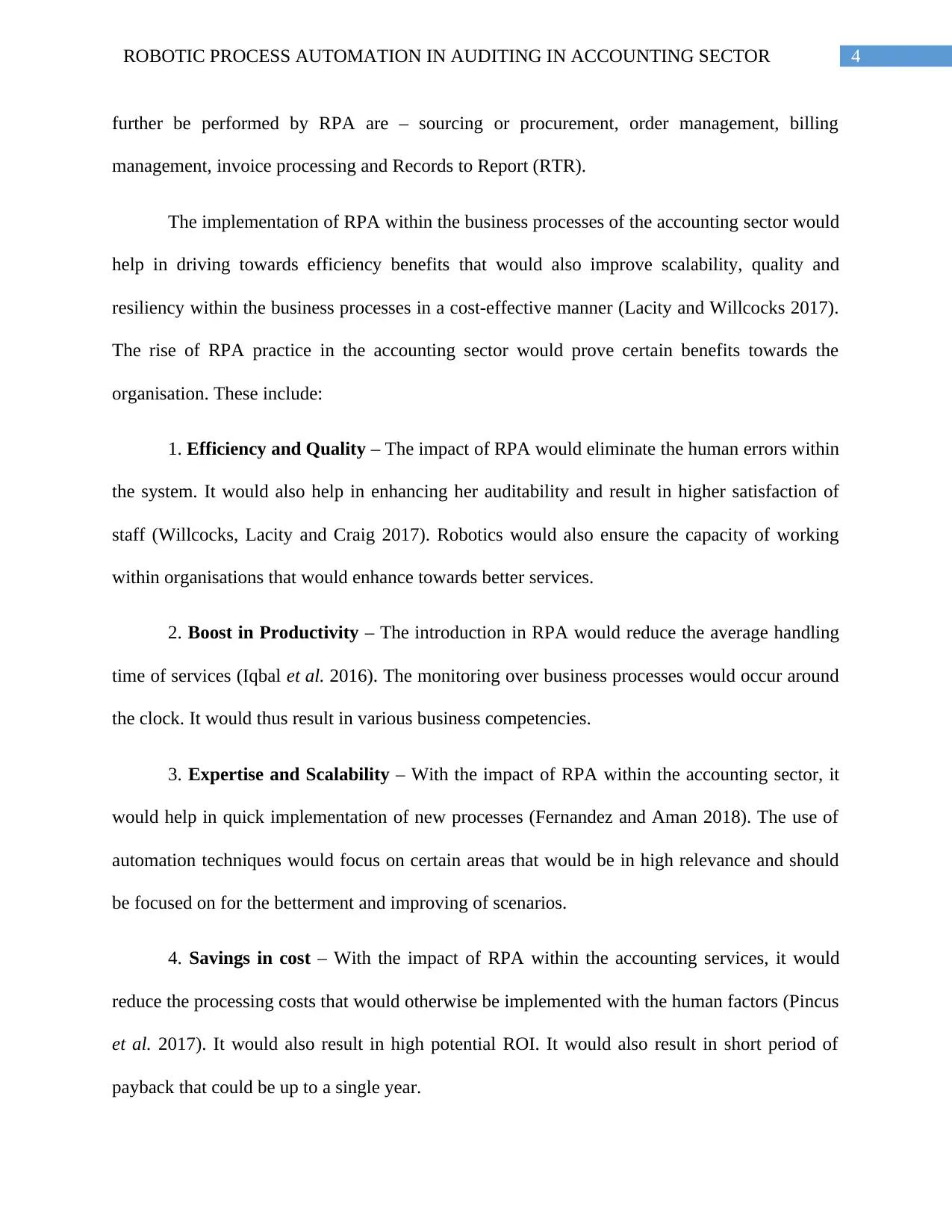
4ROBOTIC PROCESS AUTOMATION IN AUDITING IN ACCOUNTING SECTOR
further be performed by RPA are – sourcing or procurement, order management, billing
management, invoice processing and Records to Report (RTR).
The implementation of RPA within the business processes of the accounting sector would
help in driving towards efficiency benefits that would also improve scalability, quality and
resiliency within the business processes in a cost-effective manner (Lacity and Willcocks 2017).
The rise of RPA practice in the accounting sector would prove certain benefits towards the
organisation. These include:
1. Efficiency and Quality – The impact of RPA would eliminate the human errors within
the system. It would also help in enhancing her auditability and result in higher satisfaction of
staff (Willcocks, Lacity and Craig 2017). Robotics would also ensure the capacity of working
within organisations that would enhance towards better services.
2. Boost in Productivity – The introduction in RPA would reduce the average handling
time of services (Iqbal et al. 2016). The monitoring over business processes would occur around
the clock. It would thus result in various business competencies.
3. Expertise and Scalability – With the impact of RPA within the accounting sector, it
would help in quick implementation of new processes (Fernandez and Aman 2018). The use of
automation techniques would focus on certain areas that would be in high relevance and should
be focused on for the betterment and improving of scenarios.
4. Savings in cost – With the impact of RPA within the accounting services, it would
reduce the processing costs that would otherwise be implemented with the human factors (Pincus
et al. 2017). It would also result in high potential ROI. It would also result in short period of
payback that could be up to a single year.
further be performed by RPA are – sourcing or procurement, order management, billing
management, invoice processing and Records to Report (RTR).
The implementation of RPA within the business processes of the accounting sector would
help in driving towards efficiency benefits that would also improve scalability, quality and
resiliency within the business processes in a cost-effective manner (Lacity and Willcocks 2017).
The rise of RPA practice in the accounting sector would prove certain benefits towards the
organisation. These include:
1. Efficiency and Quality – The impact of RPA would eliminate the human errors within
the system. It would also help in enhancing her auditability and result in higher satisfaction of
staff (Willcocks, Lacity and Craig 2017). Robotics would also ensure the capacity of working
within organisations that would enhance towards better services.
2. Boost in Productivity – The introduction in RPA would reduce the average handling
time of services (Iqbal et al. 2016). The monitoring over business processes would occur around
the clock. It would thus result in various business competencies.
3. Expertise and Scalability – With the impact of RPA within the accounting sector, it
would help in quick implementation of new processes (Fernandez and Aman 2018). The use of
automation techniques would focus on certain areas that would be in high relevance and should
be focused on for the betterment and improving of scenarios.
4. Savings in cost – With the impact of RPA within the accounting services, it would
reduce the processing costs that would otherwise be implemented with the human factors (Pincus
et al. 2017). It would also result in high potential ROI. It would also result in short period of
payback that could be up to a single year.
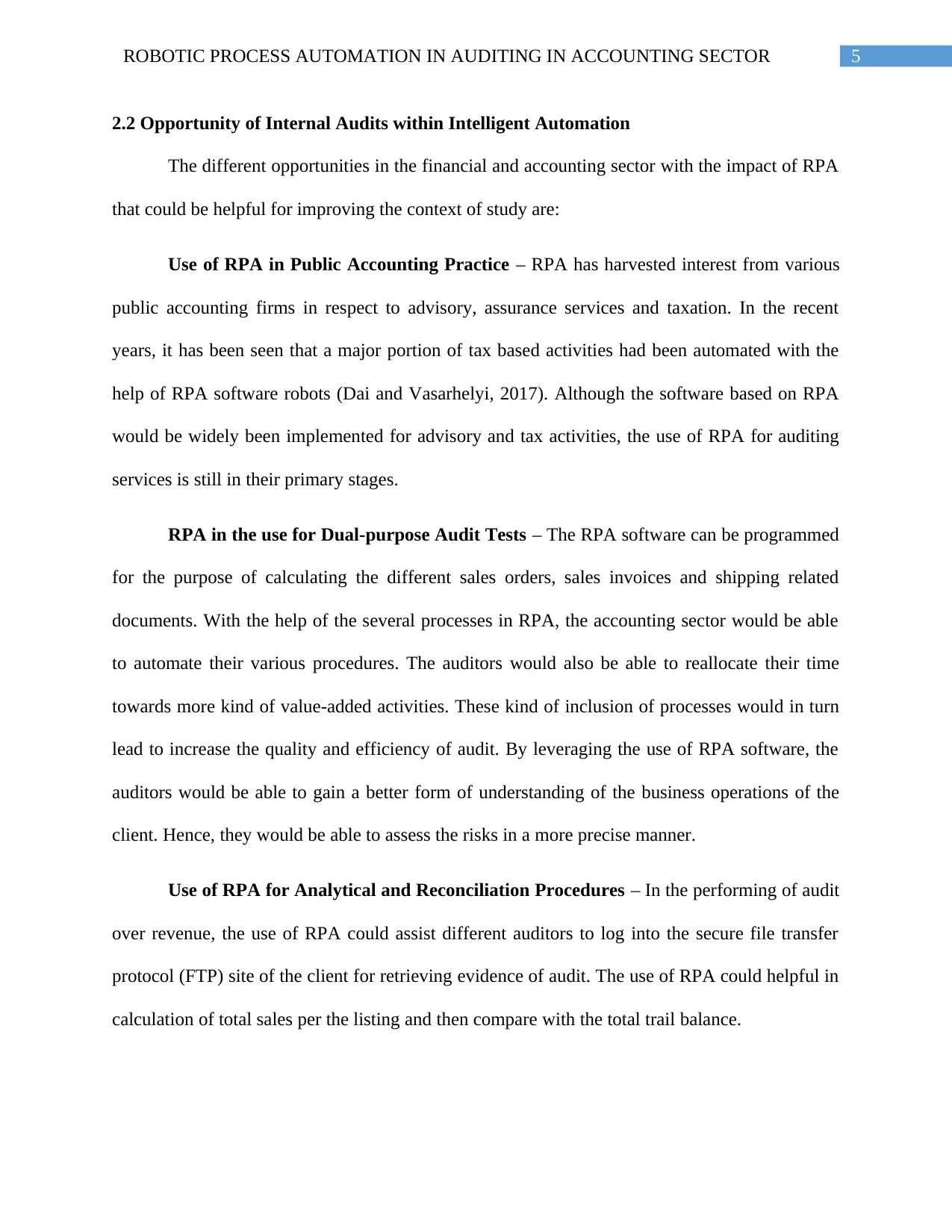
5ROBOTIC PROCESS AUTOMATION IN AUDITING IN ACCOUNTING SECTOR
2.2 Opportunity of Internal Audits within Intelligent Automation
The different opportunities in the financial and accounting sector with the impact of RPA
that could be helpful for improving the context of study are:
Use of RPA in Public Accounting Practice – RPA has harvested interest from various
public accounting firms in respect to advisory, assurance services and taxation. In the recent
years, it has been seen that a major portion of tax based activities had been automated with the
help of RPA software robots (Dai and Vasarhelyi, 2017). Although the software based on RPA
would be widely been implemented for advisory and tax activities, the use of RPA for auditing
services is still in their primary stages.
RPA in the use for Dual-purpose Audit Tests – The RPA software can be programmed
for the purpose of calculating the different sales orders, sales invoices and shipping related
documents. With the help of the several processes in RPA, the accounting sector would be able
to automate their various procedures. The auditors would also be able to reallocate their time
towards more kind of value-added activities. These kind of inclusion of processes would in turn
lead to increase the quality and efficiency of audit. By leveraging the use of RPA software, the
auditors would be able to gain a better form of understanding of the business operations of the
client. Hence, they would be able to assess the risks in a more precise manner.
Use of RPA for Analytical and Reconciliation Procedures – In the performing of audit
over revenue, the use of RPA could assist different auditors to log into the secure file transfer
protocol (FTP) site of the client for retrieving evidence of audit. The use of RPA could helpful in
calculation of total sales per the listing and then compare with the total trail balance.
2.2 Opportunity of Internal Audits within Intelligent Automation
The different opportunities in the financial and accounting sector with the impact of RPA
that could be helpful for improving the context of study are:
Use of RPA in Public Accounting Practice – RPA has harvested interest from various
public accounting firms in respect to advisory, assurance services and taxation. In the recent
years, it has been seen that a major portion of tax based activities had been automated with the
help of RPA software robots (Dai and Vasarhelyi, 2017). Although the software based on RPA
would be widely been implemented for advisory and tax activities, the use of RPA for auditing
services is still in their primary stages.
RPA in the use for Dual-purpose Audit Tests – The RPA software can be programmed
for the purpose of calculating the different sales orders, sales invoices and shipping related
documents. With the help of the several processes in RPA, the accounting sector would be able
to automate their various procedures. The auditors would also be able to reallocate their time
towards more kind of value-added activities. These kind of inclusion of processes would in turn
lead to increase the quality and efficiency of audit. By leveraging the use of RPA software, the
auditors would be able to gain a better form of understanding of the business operations of the
client. Hence, they would be able to assess the risks in a more precise manner.
Use of RPA for Analytical and Reconciliation Procedures – In the performing of audit
over revenue, the use of RPA could assist different auditors to log into the secure file transfer
protocol (FTP) site of the client for retrieving evidence of audit. The use of RPA could helpful in
calculation of total sales per the listing and then compare with the total trail balance.
⊘ This is a preview!⊘
Do you want full access?
Subscribe today to unlock all pages.

Trusted by 1+ million students worldwide
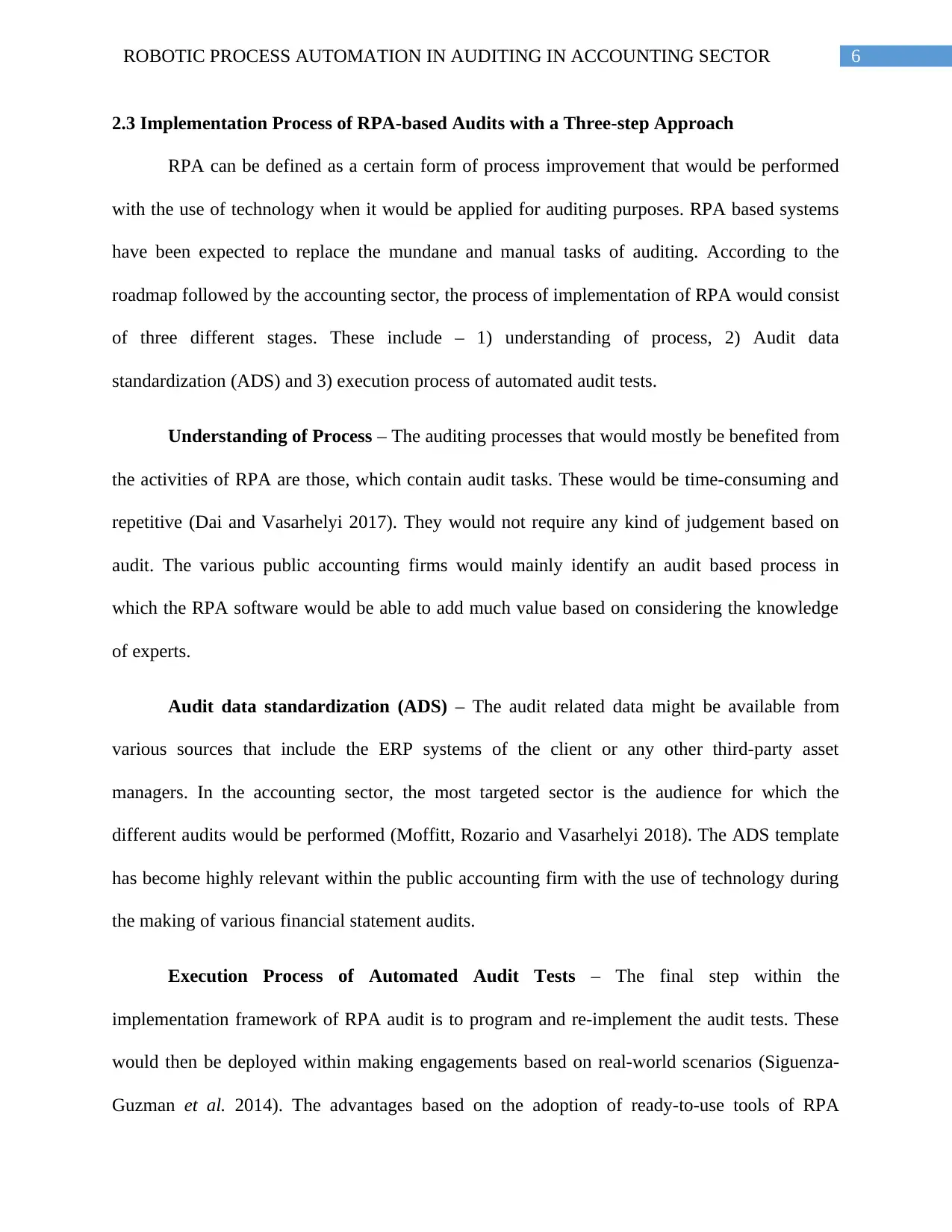
6ROBOTIC PROCESS AUTOMATION IN AUDITING IN ACCOUNTING SECTOR
2.3 Implementation Process of RPA-based Audits with a Three-step Approach
RPA can be defined as a certain form of process improvement that would be performed
with the use of technology when it would be applied for auditing purposes. RPA based systems
have been expected to replace the mundane and manual tasks of auditing. According to the
roadmap followed by the accounting sector, the process of implementation of RPA would consist
of three different stages. These include – 1) understanding of process, 2) Audit data
standardization (ADS) and 3) execution process of automated audit tests.
Understanding of Process – The auditing processes that would mostly be benefited from
the activities of RPA are those, which contain audit tasks. These would be time-consuming and
repetitive (Dai and Vasarhelyi 2017). They would not require any kind of judgement based on
audit. The various public accounting firms would mainly identify an audit based process in
which the RPA software would be able to add much value based on considering the knowledge
of experts.
Audit data standardization (ADS) – The audit related data might be available from
various sources that include the ERP systems of the client or any other third-party asset
managers. In the accounting sector, the most targeted sector is the audience for which the
different audits would be performed (Moffitt, Rozario and Vasarhelyi 2018). The ADS template
has become highly relevant within the public accounting firm with the use of technology during
the making of various financial statement audits.
Execution Process of Automated Audit Tests – The final step within the
implementation framework of RPA audit is to program and re-implement the audit tests. These
would then be deployed within making engagements based on real-world scenarios (Siguenza-
Guzman et al. 2014). The advantages based on the adoption of ready-to-use tools of RPA
2.3 Implementation Process of RPA-based Audits with a Three-step Approach
RPA can be defined as a certain form of process improvement that would be performed
with the use of technology when it would be applied for auditing purposes. RPA based systems
have been expected to replace the mundane and manual tasks of auditing. According to the
roadmap followed by the accounting sector, the process of implementation of RPA would consist
of three different stages. These include – 1) understanding of process, 2) Audit data
standardization (ADS) and 3) execution process of automated audit tests.
Understanding of Process – The auditing processes that would mostly be benefited from
the activities of RPA are those, which contain audit tasks. These would be time-consuming and
repetitive (Dai and Vasarhelyi 2017). They would not require any kind of judgement based on
audit. The various public accounting firms would mainly identify an audit based process in
which the RPA software would be able to add much value based on considering the knowledge
of experts.
Audit data standardization (ADS) – The audit related data might be available from
various sources that include the ERP systems of the client or any other third-party asset
managers. In the accounting sector, the most targeted sector is the audience for which the
different audits would be performed (Moffitt, Rozario and Vasarhelyi 2018). The ADS template
has become highly relevant within the public accounting firm with the use of technology during
the making of various financial statement audits.
Execution Process of Automated Audit Tests – The final step within the
implementation framework of RPA audit is to program and re-implement the audit tests. These
would then be deployed within making engagements based on real-world scenarios (Siguenza-
Guzman et al. 2014). The advantages based on the adoption of ready-to-use tools of RPA
Paraphrase This Document
Need a fresh take? Get an instant paraphrase of this document with our AI Paraphraser

7ROBOTIC PROCESS AUTOMATION IN AUDITING IN ACCOUNTING SECTOR
software is that they would not require additional kind of programming. Some of the
programming languages such as R and Python could help in assisting with the deployment of
RPA supported audit tasks (Bezzo et al. 2015). The discussed programming languages have
supported libraries that would be useful for performing RPA functions.
3. Conclusion
Based on the discussion from the above report, it could be concluded that the use of RPA
within the business functions of the financial and accounting sector have been useful for
improving the various processes of the sector. There are different virtual business sectors that are
highly investing in advanced technologies such as Robotic Process Automation (RPA),
predictive analytics, artificial intelligence, machine learning and natural language processing.
These are mostly been used for automating the work processes in the accounting sector.
The report helps in focusing over the business processes that would be helpful for
improving the working processes of Big Phore. The company is in the process of gathering
knowledge about the proper kind of business outcomes that would be implemented with the use
of technology. Hence, this report discusses about the importance of RPA that could be
implemented within the accounting sector of Big Phore. The discussion in this article also puts
focus over the various programming languages such as Python and R, which could be
implemented within the RPA technology for improving the technology and increasing processing
efficiency. Based on the discussion from the report, it could be concluded that RPA would be
helpful for improving the business processes of the organisation and enhancing the experience of
customers in the auditing sector.
software is that they would not require additional kind of programming. Some of the
programming languages such as R and Python could help in assisting with the deployment of
RPA supported audit tasks (Bezzo et al. 2015). The discussed programming languages have
supported libraries that would be useful for performing RPA functions.
3. Conclusion
Based on the discussion from the above report, it could be concluded that the use of RPA
within the business functions of the financial and accounting sector have been useful for
improving the various processes of the sector. There are different virtual business sectors that are
highly investing in advanced technologies such as Robotic Process Automation (RPA),
predictive analytics, artificial intelligence, machine learning and natural language processing.
These are mostly been used for automating the work processes in the accounting sector.
The report helps in focusing over the business processes that would be helpful for
improving the working processes of Big Phore. The company is in the process of gathering
knowledge about the proper kind of business outcomes that would be implemented with the use
of technology. Hence, this report discusses about the importance of RPA that could be
implemented within the accounting sector of Big Phore. The discussion in this article also puts
focus over the various programming languages such as Python and R, which could be
implemented within the RPA technology for improving the technology and increasing processing
efficiency. Based on the discussion from the report, it could be concluded that RPA would be
helpful for improving the business processes of the organisation and enhancing the experience of
customers in the auditing sector.
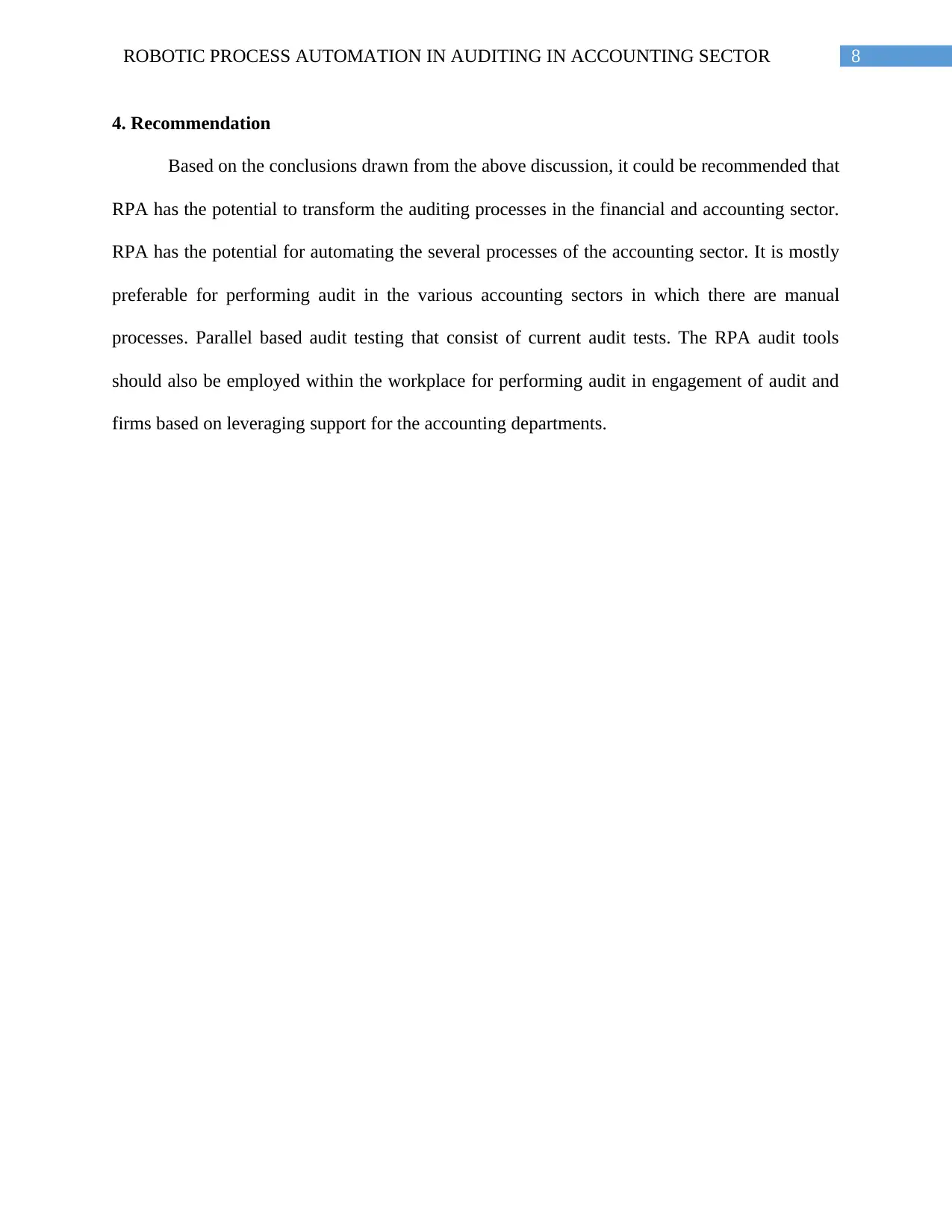
8ROBOTIC PROCESS AUTOMATION IN AUDITING IN ACCOUNTING SECTOR
4. Recommendation
Based on the conclusions drawn from the above discussion, it could be recommended that
RPA has the potential to transform the auditing processes in the financial and accounting sector.
RPA has the potential for automating the several processes of the accounting sector. It is mostly
preferable for performing audit in the various accounting sectors in which there are manual
processes. Parallel based audit testing that consist of current audit tests. The RPA audit tools
should also be employed within the workplace for performing audit in engagement of audit and
firms based on leveraging support for the accounting departments.
4. Recommendation
Based on the conclusions drawn from the above discussion, it could be recommended that
RPA has the potential to transform the auditing processes in the financial and accounting sector.
RPA has the potential for automating the several processes of the accounting sector. It is mostly
preferable for performing audit in the various accounting sectors in which there are manual
processes. Parallel based audit testing that consist of current audit tests. The RPA audit tools
should also be employed within the workplace for performing audit in engagement of audit and
firms based on leveraging support for the accounting departments.
⊘ This is a preview!⊘
Do you want full access?
Subscribe today to unlock all pages.

Trusted by 1+ million students worldwide
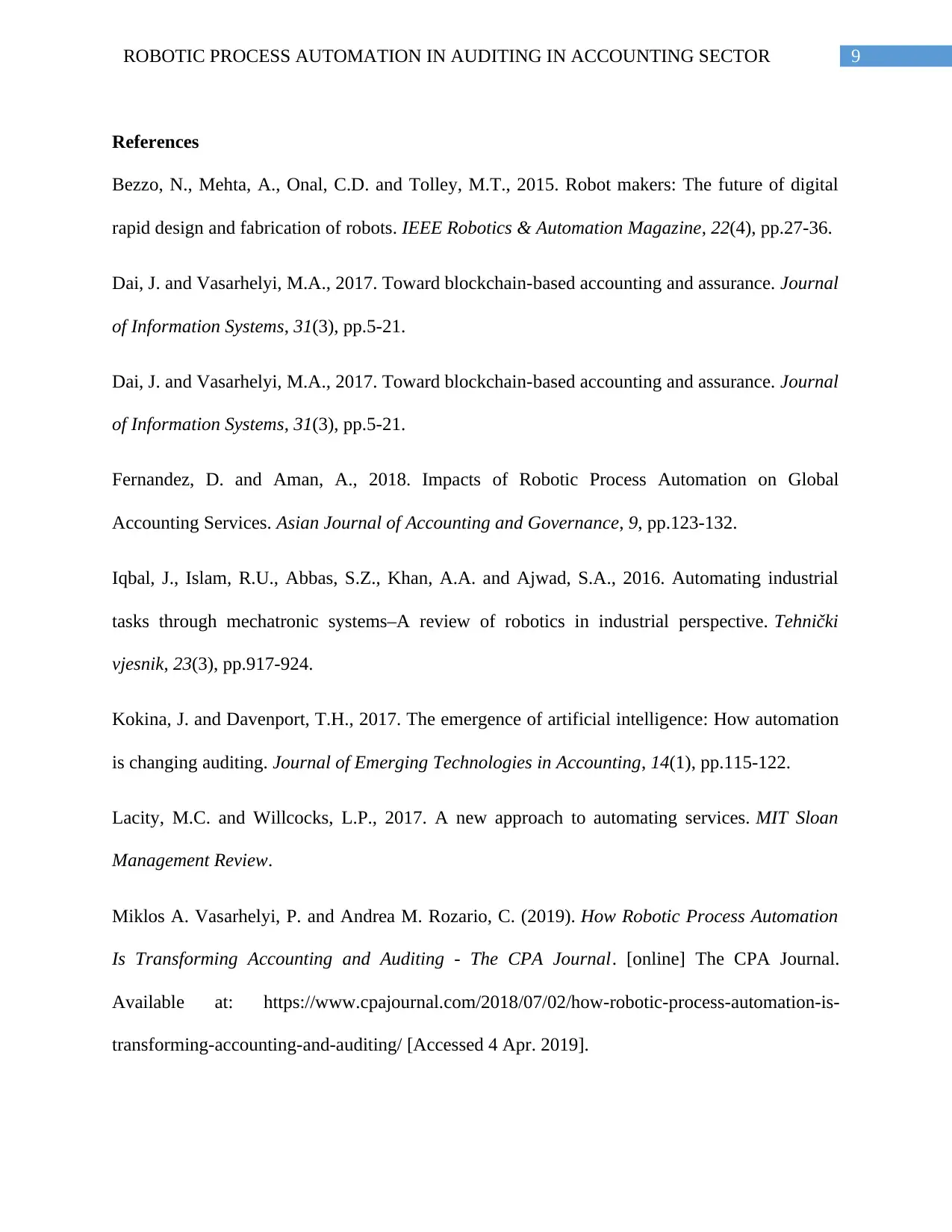
9ROBOTIC PROCESS AUTOMATION IN AUDITING IN ACCOUNTING SECTOR
References
Bezzo, N., Mehta, A., Onal, C.D. and Tolley, M.T., 2015. Robot makers: The future of digital
rapid design and fabrication of robots. IEEE Robotics & Automation Magazine, 22(4), pp.27-36.
Dai, J. and Vasarhelyi, M.A., 2017. Toward blockchain-based accounting and assurance. Journal
of Information Systems, 31(3), pp.5-21.
Dai, J. and Vasarhelyi, M.A., 2017. Toward blockchain-based accounting and assurance. Journal
of Information Systems, 31(3), pp.5-21.
Fernandez, D. and Aman, A., 2018. Impacts of Robotic Process Automation on Global
Accounting Services. Asian Journal of Accounting and Governance, 9, pp.123-132.
Iqbal, J., Islam, R.U., Abbas, S.Z., Khan, A.A. and Ajwad, S.A., 2016. Automating industrial
tasks through mechatronic systems–A review of robotics in industrial perspective. Tehnički
vjesnik, 23(3), pp.917-924.
Kokina, J. and Davenport, T.H., 2017. The emergence of artificial intelligence: How automation
is changing auditing. Journal of Emerging Technologies in Accounting, 14(1), pp.115-122.
Lacity, M.C. and Willcocks, L.P., 2017. A new approach to automating services. MIT Sloan
Management Review.
Miklos A. Vasarhelyi, P. and Andrea M. Rozario, C. (2019). How Robotic Process Automation
Is Transforming Accounting and Auditing - The CPA Journal. [online] The CPA Journal.
Available at: https://www.cpajournal.com/2018/07/02/how-robotic-process-automation-is-
transforming-accounting-and-auditing/ [Accessed 4 Apr. 2019].
References
Bezzo, N., Mehta, A., Onal, C.D. and Tolley, M.T., 2015. Robot makers: The future of digital
rapid design and fabrication of robots. IEEE Robotics & Automation Magazine, 22(4), pp.27-36.
Dai, J. and Vasarhelyi, M.A., 2017. Toward blockchain-based accounting and assurance. Journal
of Information Systems, 31(3), pp.5-21.
Dai, J. and Vasarhelyi, M.A., 2017. Toward blockchain-based accounting and assurance. Journal
of Information Systems, 31(3), pp.5-21.
Fernandez, D. and Aman, A., 2018. Impacts of Robotic Process Automation on Global
Accounting Services. Asian Journal of Accounting and Governance, 9, pp.123-132.
Iqbal, J., Islam, R.U., Abbas, S.Z., Khan, A.A. and Ajwad, S.A., 2016. Automating industrial
tasks through mechatronic systems–A review of robotics in industrial perspective. Tehnički
vjesnik, 23(3), pp.917-924.
Kokina, J. and Davenport, T.H., 2017. The emergence of artificial intelligence: How automation
is changing auditing. Journal of Emerging Technologies in Accounting, 14(1), pp.115-122.
Lacity, M.C. and Willcocks, L.P., 2017. A new approach to automating services. MIT Sloan
Management Review.
Miklos A. Vasarhelyi, P. and Andrea M. Rozario, C. (2019). How Robotic Process Automation
Is Transforming Accounting and Auditing - The CPA Journal. [online] The CPA Journal.
Available at: https://www.cpajournal.com/2018/07/02/how-robotic-process-automation-is-
transforming-accounting-and-auditing/ [Accessed 4 Apr. 2019].
Paraphrase This Document
Need a fresh take? Get an instant paraphrase of this document with our AI Paraphraser

10ROBOTIC PROCESS AUTOMATION IN AUDITING IN ACCOUNTING SECTOR
Moffitt, K.C., Rozario, A.M. and Vasarhelyi, M.A., 2018. Robotic Process Automation for
Auditing. Journal of Emerging Technologies in Accounting, 15(1), pp.1-10.
Pincus, K.V., Stout, D.E., Sorensen, J.E., Stocks, K.D. and Lawson, R.A., 2017. Forces for
change in higher education and implications for the accounting academy. Journal of Accounting
Education, 40, pp.1-18.
Siguenza-Guzman, L., Van den Abbeele, A., Vandewalle, J., Verhaaren, H. and Cattrysse, D.,
2014. Using Time-Driven Activity-Based Costing to support library management decisions: A
case study for lending and returning processes. The Library Quarterly, 84(1), pp.76-98.
Willcocks, L., Lacity, M. and Craig, A., 2017. Robotic process automation: strategic
transformation lever for global business services?. Journal of Information Technology Teaching
Cases, 7(1), pp.17-28.
Moffitt, K.C., Rozario, A.M. and Vasarhelyi, M.A., 2018. Robotic Process Automation for
Auditing. Journal of Emerging Technologies in Accounting, 15(1), pp.1-10.
Pincus, K.V., Stout, D.E., Sorensen, J.E., Stocks, K.D. and Lawson, R.A., 2017. Forces for
change in higher education and implications for the accounting academy. Journal of Accounting
Education, 40, pp.1-18.
Siguenza-Guzman, L., Van den Abbeele, A., Vandewalle, J., Verhaaren, H. and Cattrysse, D.,
2014. Using Time-Driven Activity-Based Costing to support library management decisions: A
case study for lending and returning processes. The Library Quarterly, 84(1), pp.76-98.
Willcocks, L., Lacity, M. and Craig, A., 2017. Robotic process automation: strategic
transformation lever for global business services?. Journal of Information Technology Teaching
Cases, 7(1), pp.17-28.
1 out of 11
Related Documents
Your All-in-One AI-Powered Toolkit for Academic Success.
+13062052269
info@desklib.com
Available 24*7 on WhatsApp / Email
![[object Object]](/_next/static/media/star-bottom.7253800d.svg)
Unlock your academic potential
Copyright © 2020–2025 A2Z Services. All Rights Reserved. Developed and managed by ZUCOL.





